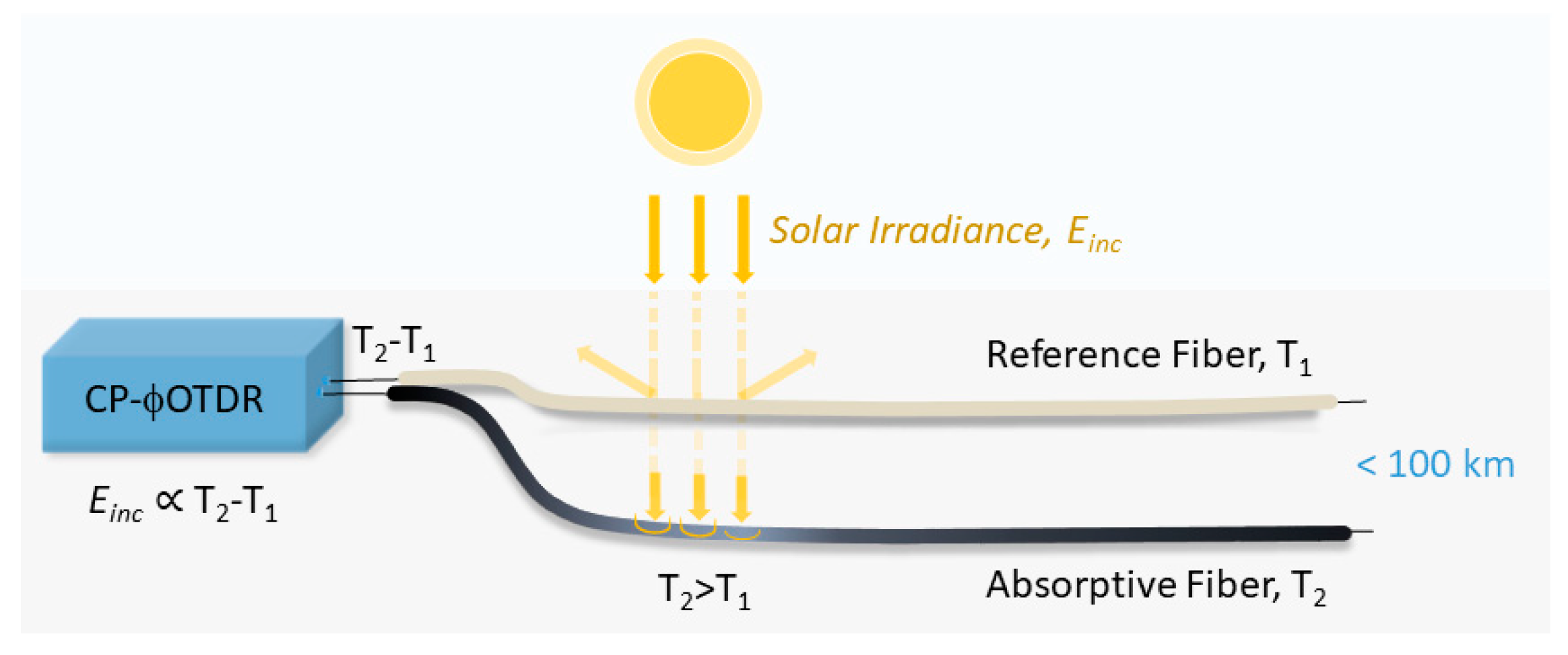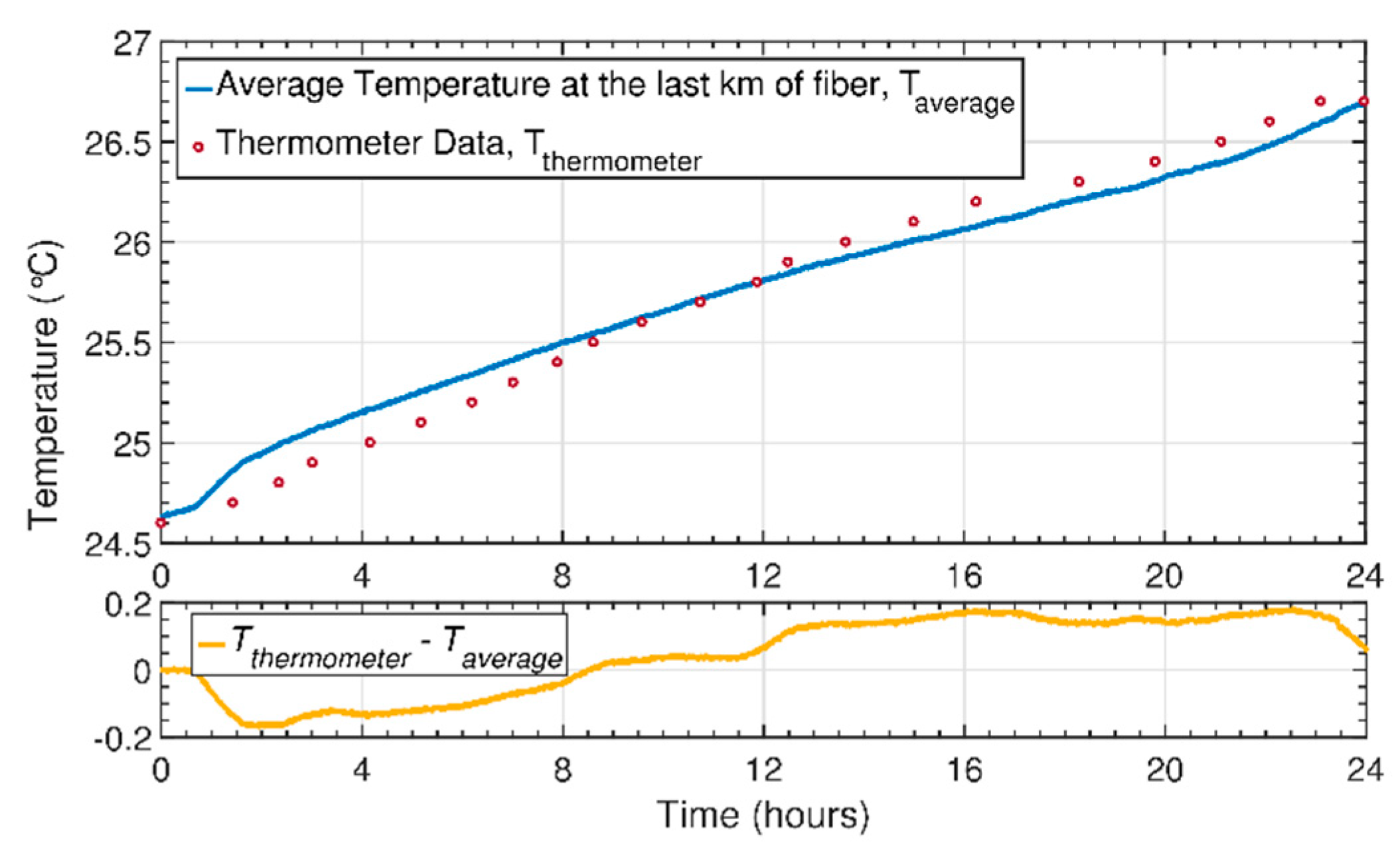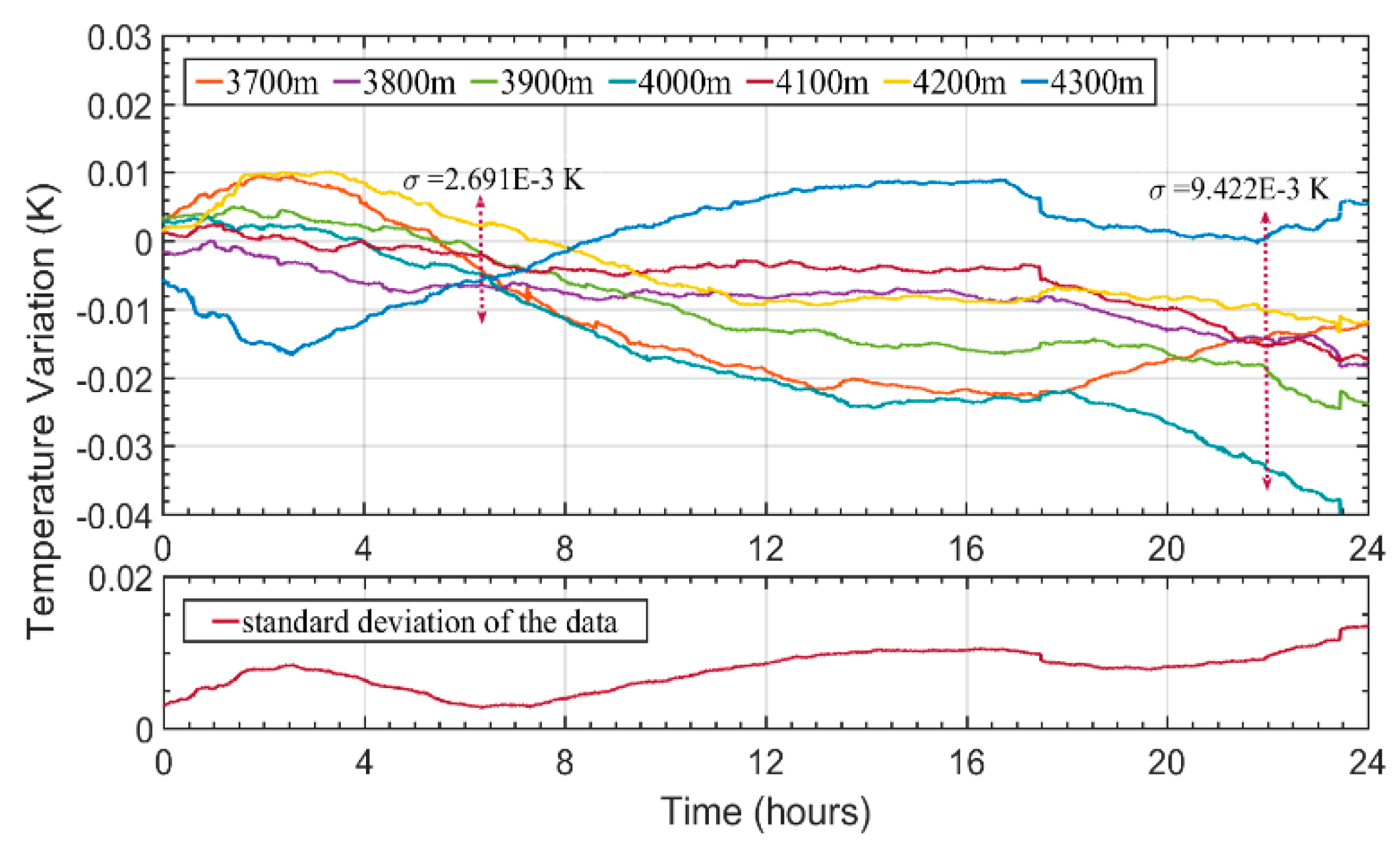Long-Range Distributed Solar Irradiance Sensing Using Optical Fibers
Abstract
:1. Introduction
2. Theoretical Principles
2.1. Principle of Bolometry
2.2. Developing a Long-Range Distributed Fiber-Based Bolometer
2.3. Distributed Fiber Temperature Interrogator: CP-ϕOTDR
3. Materials and Methods
3.1. CP-ϕOTDR:Distributed Temperature Sensing Scheme
3.2. Solar Irradiance Application Scheme
4. Results
4.1. Proof-of-Concept
4.2. 24-h Temperature Experiment
5. Conclusions
Author Contributions
Funding
Conflicts of Interest
References
- Antonanzas-Torres, J.F.; Cañizares, F.; Perpiñán, O. Comparative assessment of global irradiation from a satellite estimate model (CM SAF) and on-ground measurements (SIAR): A Spanish case study. Renew. Sustain. Energy Rev. 2013, 21, 248–261. [Google Scholar] [CrossRef] [Green Version]
- Wild, M. Global dimming and brightening: A review. J. Geophys. Res. Atmos. 2009, 114, D00D16. [Google Scholar] [CrossRef] [Green Version]
- Polo, J.; Wilbert, S.; Ruiz-Arias, J.A.; Meyer, R.; Gueymard, C.; Suri, M.; Martín, L.; Mieslinger, T.; Blanc, P.; Grantet, I.; et al. Preliminary survey on site-adaptation techniques for satellite-derived and reanalysis solar radiation datasets. Solar Energy 2019, 132, 25–37. [Google Scholar] [CrossRef]
- Hammer, A.; Heinemann, D.; Hoyer, C.; Kuhlemann, R.; Lorenz, E.; Müller, R.; Beyer, H.G. Solar energy assessment using remote sensing technologies. Remote Sens. Environ. 2003, 86, 423–432. [Google Scholar] [CrossRef]
- Paulescu, M.; Paulescu, E. Short-term forecasting of solar irradiance. Renew. Energy 2019, 143, 985–994. [Google Scholar] [CrossRef]
- Voyant, C.; Notton, G.; Kalogirou, S.; Nivet, M.L.; Paoli, C.; Motte, F.; Fouilloy, A. Machine learning methods for solar radiation forecasting: A review. Renew. Energy 2017, 105, 569–582. [Google Scholar] [CrossRef]
- Heinemann, D.; Lorenz, E.; Girodo, M. Forecasting of solar radiation. In Solar Energy Resource Management for Electricity Generation from Local Level to Global Scale; Nova Science Publishers: New York, NY, USA, 2006. [Google Scholar]
- Polo, J.; Zarzalejo, L.F.; Ramírez, L. Solar radiation derived from satellite images. In Modeling Solar Radiation at the Earth’s Surface; Springer: Berlin/Heidelberg, Germany, 2008; pp. 449–462. [Google Scholar]
- Zarzalejo, L.F.; Polo, J.; Martín, L.; Ramírez, L.; Espinar, B. A new statistical approach for deriving global solar radiation from satellite images. Solar Energy 2009, 83, 480–484. [Google Scholar] [CrossRef]
- Geraldi, E.; Romano, F.; Ricciardelli, E. An advanced model for the estimation of the surface solar irradiance under all atmospheric conditions using MSG/SEVIRI data. IEEE Trans. Geosci. Remote Sens. 2012, 50, 2934–2953. [Google Scholar] [CrossRef]
- Perez, R.; Seals, R.; Zelenka, A. Comparing satellite remote sensing and ground network measurements for the production of site/time specific irradiance data. Sol. Energy 1997, 60, 89–96. [Google Scholar] [CrossRef]
- Reikard, G. Predicting solar radiation at high resolutions: A comparison of time series forecasts. Sol. Energy 2009, 83, 342–349. [Google Scholar] [CrossRef]
- Kerr, J.p.; Thurtell, G.W.; Tanner, C.B. Mesoscale sampling of global radiation analysis of data from Wisconsin. Mon. Wea. Rev. 1968, 96, 237–241. [Google Scholar] [CrossRef] [Green Version]
- Long, C.N.; Ackerman, T.P. Surface measurements of solar irradiance: A study of the spatial correlation between simultaneous measurements at separated sites. J. Appl. Meteorol. 1995, 34, 1039–1046. [Google Scholar] [CrossRef]
- Suckling, P.W. Extrapolation of solar radiation measurements: Mesoscale analyses from Arizona and Tennessee Valley Authority regions. J. Clim. Appl. Meteorol. 1983, 22, 488–494. [Google Scholar] [CrossRef] [Green Version]
- Suckling, P.W. Estimating daily solar radiation values in selected mid-latitude regions by extrapolating measurements from nearby stations. Sol. Energy 1985, 35, 491–495. [Google Scholar] [CrossRef]
- Hubbard, K.G. Spatial variability of daily weather variables in the high plains of the USA. Agric. For. Meteorol. 1994, 68, 29–41. [Google Scholar] [CrossRef]
- Merino, G.G.; Jones, D.; Stooksbury, D.E.; Hubbard, K.G. Determination of semivariogram models to krige hourly and daily solar irradiance in western Nebraska. J. Appl. Meteorol. 2001, 40, 1085–1094. [Google Scholar] [CrossRef]
- Michiorri, A.; Nguyen, H.M.; Alessandrini, S.; Bremnes, J.B.; Dierer, S.; Ferrero, E.; Nygaard, B.-E.; Pinson, P.; Thomaidis, N.; Uski, S. Forecasting for dynamic line rating. Renew. Sustain. Energy Rev. 2015, 52, 1713–1730. [Google Scholar] [CrossRef] [Green Version]
- Black, C.R.; Chisholm, W.A. Key considerations for the selection of dynamic thermal line rating systems. IEEE Trans. Power Deliv. 2014, 30, 2154–2162. [Google Scholar] [CrossRef]
- Joshi, B.; Kay, M.; Copper, J.K.; Sproul, A.B. Evaluation of solar irradiance forecasting skills of the Australian Bureau of Meteorology’s ACCESS models. Sol. Energy 2019, 188, 386–402. [Google Scholar] [CrossRef]
- Ukil, A.; Braendle, H.; Krippner, P. Distributed temperature sensing: Review of technology and applications. IEEE Sens. J. 2011, 12, 885–892. [Google Scholar] [CrossRef] [Green Version]
- Selker, J.S.; Thévenaz, L.; Huwald, H.; Mallet, A.; Luxemburg, W.; Van De Giesen, N.; Stejskal, M.; Zeman, J.; Westhoff, M.; Parlange, M.B. Distributed fiber-optic temperature sensing for hydrologic systems. Water Resour. Res. 2006, 42, W12202. [Google Scholar] [CrossRef] [Green Version]
- Kurashima, T.; Horiguchi, T.; Tateda, M. Distributed-temperature sensing using stimulated Brillouin scattering in optical silica fibers. Opt. Lett. 1990, 15, 1038–1040. [Google Scholar] [CrossRef] [PubMed]
- Mikhailov, S.; Zhang, L.; Geernaert, T.; Berghmans, F.; Thevenaz, L. Distributed hydrostatic pressure measurement using phase OTDR in a highly birefringent photonic crystal fiber. J. Lightwave Technol. 2019, 37, 4496–4500. [Google Scholar] [CrossRef]
- Chen, T.; Wang, Q.; Chen, R.; Zhang, B.; Jewart, C.; Chen, K.P.; Maklad, M.; Swinehart, P.R. Distributed high-temperature pressure sensing using air-hole microstructural fibers. Opt. Lett. 2012, 37, 1064–1066. [Google Scholar] [CrossRef] [Green Version]
- Kim, Y.H.; Kwon, H.; Kim, J.; Song, K.Y. Distributed measurement of hydrostatic pressure based on Brillouin dynamic grating in polarization maintaining fibers. Opt. Express 2016, 24, 21399–21406. [Google Scholar] [CrossRef]
- Smith, J.; Brown, A.; De Merchant, M.; Bao, X. Simultaneous distributed strain and temperature measurement. Appl. Opt. 1999, 38, 5372–5377. [Google Scholar] [CrossRef]
- Garcia-Ruiz, A.; Martins, H.F.; Pastor-Graells, J.; Martin-Lopez, S.; Gonzalez-Herraez, M. Single-Shot true distributed strain variation measurements over> 10 km using phase-sensitive OTDR with chirped pulses. In Proceedings of the Asia-Pacific Optical Sensors Conference, Shanghai, China, 11–14 October 2016. [Google Scholar]
- Zhou, L.; Wang, F.; Wang, X.; Pan, Y.; Sun, Z.; Hua, J.; Zhang, X. Distributed strain and vibration sensing system based on phase-sensitive OTDR. IEEE Photonics Technol. Lett. 2015, 27, 1884–1887. [Google Scholar] [CrossRef]
- Bao, X.; Chen, L. Recent progress in distributed fiber optic sensors. Sensors 2012, 12, 8601–8639. [Google Scholar] [CrossRef] [Green Version]
- Barrias, A.; Casas, J.R.; Villalba, S. A review of distributed optical fiber sensors for civil engineering applications. Sensors 2016, 16, 748. [Google Scholar] [CrossRef] [Green Version]
- Magalhães, R.; Pereira, J.; Garcia-Ruiz, A.; Margulis, W.; Martin-Lopez, S.; Gonzalez-Herraez, M.; Martins, H.F. Distributed detection of quadratic Kerr effect in silica fibers using chirped-pulse ΦOTDR. In Proceedings of the Seventh European Workshop on Optical Fibre Sensors, Limassol, Cyprus, 1–4 October 2019. [Google Scholar]
- Fernández-Ruiz, M.R.; Williams, E.L.; Magalhaes, R.; Vanthillo, R.; Costa, L.; Zhan, Z.; Martin-Lopez, S.; Gonzalez-Herraez, M.; Martins, H.F. Teleseisms monitoring using chirped-pulse ΦOTDR. In Proceedings of the Seventh European Workshop on Optical Fibre Sensors, Limassol, Cyprus, 1–4 October 2019. [Google Scholar]
- Zhang, W.; Gao, J.; Shi, B.; Cui, H.; Zhu, H. Health monitoring of rehabilitated concrete bridges using distributed optical fiber sensing. Comput. Aided Civ. Infrastruct. Eng. 2006, 21, 411–424. [Google Scholar] [CrossRef]
- Dou, S.; Lindsey, N.; Wagner, A.M.; Daley, T.M.; Freifeld, B.; Robertson, M.; Peterson, J.; Ulrich, C.; Martin, E.R.; Ajo-Franklin, J.B. Distributed acoustic sensing for seismic monitoring of the near surface: A traffic-noise interferometry case study. Sci. Rep. 2017, 7, 11620. [Google Scholar] [CrossRef] [PubMed] [Green Version]
- Koyamada, Y.; Imahama, M.; Kubota, K.; Hogari, K. Fiber-optic distributed strain and temperature sensing with very high measurand resolution over long range using coherent OTDR. J. Lightwave Technol. 2009, 27, 1142–1146. [Google Scholar] [CrossRef]
- Pastor-Graells, J.; Martins, H.F.; Garcia-Ruiz, A.; Martin-Lopez, S.; Gonzalez-Herraez, M. Single-shot distributed temperature and strain tracking using direct detection phase-sensitive OTDR with chirped pulses. Opt. Express 2016, 24, 13121–13133. [Google Scholar] [CrossRef] [PubMed]
- Fernández-Ruiz, M.R.; Costa, L.; Martins, H.F. Distributed Acoustic Sensing Using Chirped-Pulse Phase-Sensitive OTDR Technology. Sensors 2019, 19, 4368. [Google Scholar] [CrossRef] [Green Version]
- Magalhães, R.; Garcia-Ruiz, A.; Martins, H.F.; Pereira, J.; Margulis, W.; Martin-Lopez, S.; Gonzalez-Herraez, M. Fiber-based distributed bolometry. Opt. Express 2019, 27, 4317–4328. [Google Scholar] [CrossRef] [Green Version]
- Garcia-Ruiz, A.; Pastor-Graells, J.; Martins, H.F.; Tow, K.H.; Thévenaz, L.; Martin-Lopez, S.; Gonzalez-Herraez, M. Distributed photothermal spectroscopy in microstructured optical fibers: Towards high-resolution mapping of gas presence over long distances. Opt. Express 2017, 25, 1789–1805. [Google Scholar] [CrossRef] [Green Version]
- Soto, M.A.; Lu, X.; Martins, H.F.; Gonzalez-Herraez, M.; Thévenaz, L. Distributed phase birefringence measurements based on polarization correlation in phase-sensitive optical time-domain reflectometers. Opt. Express 2015, 23, 24923–24936. [Google Scholar] [CrossRef]
- Costa, L.D.; Martins, H.F.; Martin-Lopez, S.; Fernandez-Ruiz, M.R.; Gonzalez-Herraez, M. Fully distributed optical fiber strain sensor with 10–12 ε/√Hz sensitivity. J. Lightwave Technol. 2019, 37, 4487–4495. [Google Scholar] [CrossRef]









© 2020 by the authors. Licensee MDPI, Basel, Switzerland. This article is an open access article distributed under the terms and conditions of the Creative Commons Attribution (CC BY) license (http://creativecommons.org/licenses/by/4.0/).
Share and Cite
Magalhães, R.; Costa, L.; Martin-Lopez, S.; Gonzalez-Herraez, M.; Braña, A.F.; Martins, H.F. Long-Range Distributed Solar Irradiance Sensing Using Optical Fibers. Sensors 2020, 20, 908. https://doi.org/10.3390/s20030908
Magalhães R, Costa L, Martin-Lopez S, Gonzalez-Herraez M, Braña AF, Martins HF. Long-Range Distributed Solar Irradiance Sensing Using Optical Fibers. Sensors. 2020; 20(3):908. https://doi.org/10.3390/s20030908
Chicago/Turabian StyleMagalhães, Regina, Luis Costa, Sonia Martin-Lopez, Miguel Gonzalez-Herraez, Alejandro F. Braña, and Hugo F. Martins. 2020. "Long-Range Distributed Solar Irradiance Sensing Using Optical Fibers" Sensors 20, no. 3: 908. https://doi.org/10.3390/s20030908
APA StyleMagalhães, R., Costa, L., Martin-Lopez, S., Gonzalez-Herraez, M., Braña, A. F., & Martins, H. F. (2020). Long-Range Distributed Solar Irradiance Sensing Using Optical Fibers. Sensors, 20(3), 908. https://doi.org/10.3390/s20030908




